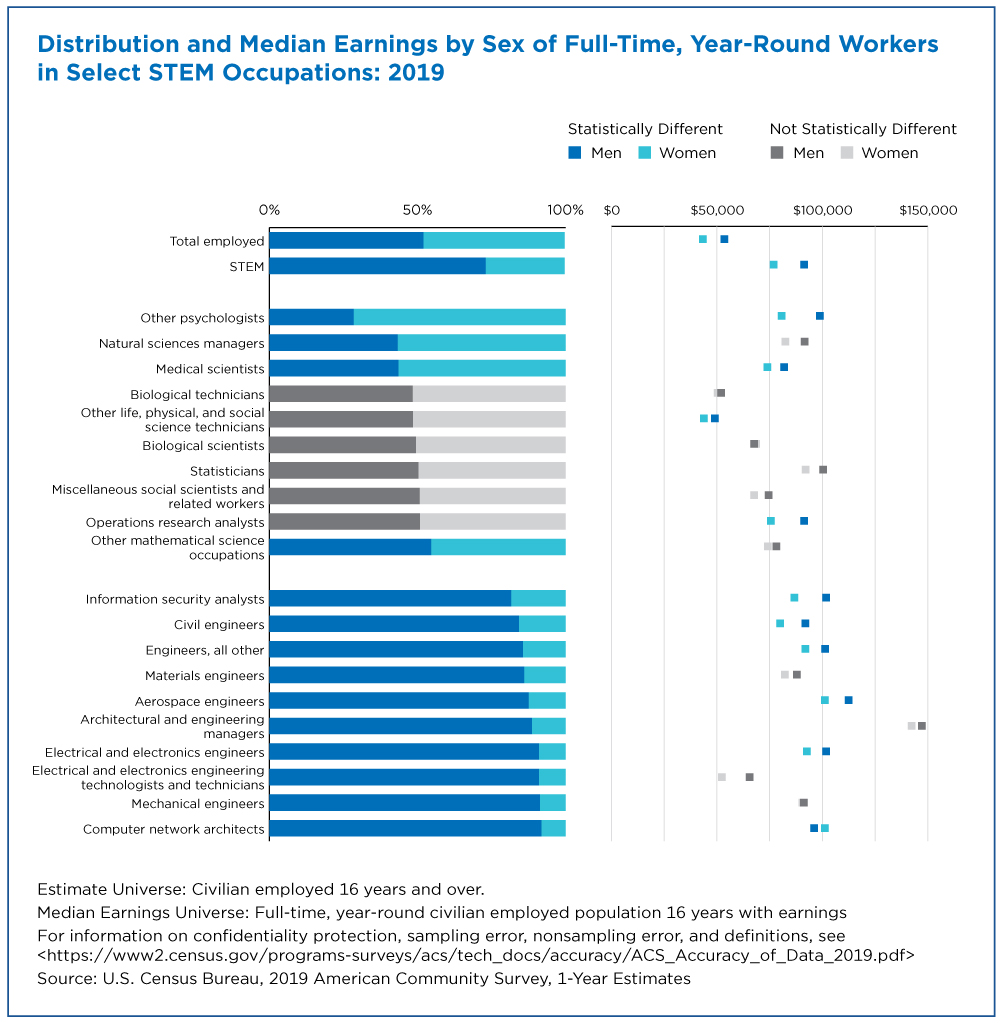Women Are Nearly Half of U.S. Workforce but Only 27% of STEM Workers
Despite making up nearly half of the U.S. workforce, women are still vastly underrepresented in the science, technology, engineering and math (STEM) workforce.
Women made gains – from 8% of STEM workers in 1970 to 27% in 2019 – but men still dominated the field. Men made up 52% of all U.S. workers but 73% of all STEM workers.
In 1970, women made up 38% of all U.S. workers and 8% of STEM workers. By 2019, the STEM proportion had increased to 27% and women made up 48% of all workers.
STEM occupations account for nearly 7% of all U.S. occupations and STEM workers play an important role in America’s innovative capacity and global competitiveness. They are our engineers, medical scientists, sociologists and informational security analysts.
National STEM/STEAM Day is celebrated every year on Nov. 8 to encourage kids to explore their interests in the fields of science, technology, engineering, art, and math.
In 2019, there were nearly 10.8 million workers in STEM occupations, according to Census Bureau estimates.
Major Occupations |
|---|
STEM |
| Computer (including computer and information systems managers) Mathematical Engineering (including architectural and engineering managers and sales engineers) Life science, physical science, and social science (including natural sciences managers, excluding occupational health and safety specialists and technicians) |
STEM-related |
| Architects, except naval Health care and technical practitioners (including medical and health services managers) |
Non-STEM |
| Management Business and financial operations Community and social service Legal Educational instruction and library Arts, design, entertainment, sports, and media Health care support Protective service Food preparation and serving Building and grounds cleaning and maintenance Personal care and service Sales and related Office and administrative support Farming, fishing, and forestry Construction and extraction Installation, maintenance, and repair Production Transportation Material moving |
Women Make Gains in Some STEM Occupations
In 1970, women made up 38% of all U.S. workers and 8% of STEM workers. By 2019, the STEM proportion had increased to 27% and women made up 48% of all workers.
Since 1970, the representation of women has increased across all STEM occupations and they made significant gains in social science occupations in particular – from 19% in 1970 to 64% in 2019.
Women in 2019 also made up nearly half of those in all math (47%) and life and physical science (45%) occupations.
However, women did not make as big gains in computer and engineering occupations, which made up the largest portion (80%) of the STEM workforce.
Women represented only about a quarter of computer workers and 15% of those in engineering occupations. They were, however, a majority of the nation’s social scientists. But social science accounted for only 3% of STEM occupations.
Women working in engineering occupations increased from 3% in 1970 to 15% in 2019. And while the percentage of women in computer occupations is higher than in 1970, it actually decreased between 1990 and 2019.
What Women Earn
Women employed full-time, year-round in STEM occupations earned more than their non-STEM counterparts but the gender earnings gap persisted within STEM occupations.
In STEM occupations that are majority women and have enough of a sample to meet statistical standards for reliability, (other psychologists, natural sciences managers, and medical scientists) women employed full-time year-round earned less or about the same as men.
Among the 70 detailed STEM occupations the Census Bureau reports on, women earned more than men in only one STEM occupation: computer network architects. But women represented only 8% of those in this occupation.
Much of the data highlighted above come from a recently released detailed table from the American Community Survey and provide information on specific STEM occupations and earnings for women and men.
Related Statistics
-
Stats for StoriesNational STEM Day: November 8, 2024The American Community Survey estimates 10.8M Americans 16+ were employed in STEM occupations in 2021, 26.7% women who earned 84.1% as much as men.
-
Stats for StoriesWomen’s Equality Day: August 26, 2023According to the Current Population Survey, 2020 voter turnout was 68.4% for women and 65.0% for men. About 9.7 million more women than men voted.
Subscribe
Our email newsletter is sent out on the day we publish a story. Get an alert directly in your inbox to read, share and blog about our newest stories.
Contact our Public Information Office for media inquiries or interviews.
-
America Counts StoryCost of Motherhood on Women’s Employment and EarningsJune 16, 2020Labor force participation plummets when women have children, though earnings partially recover.
-
America Counts StoryThe Choices Working Mothers MakeMay 08, 2020In honor of Mother’s Day, here is a look at working mothers with children under age 18 and how their experience in the workforce changes as their children age.
-
America Counts StoryEqual Pay Day is March 31 – the Earliest Since it Began in 1996March 31, 2020In 2018, women earned 81.6 cents to every dollar men earned. The gap is narrowing and Equal Pay Day is today, the earliest it’s ever been.
-
EmploymentThe Stories Behind Census Numbers in 2025December 22, 2025A year-end review of America Counts stories on everything from families and housing to business and income.
-
Families and Living ArrangementsMore First-Time Moms Live With an Unmarried PartnerDecember 16, 2025About a quarter of all first-time mothers were cohabiting at the time of childbirth in the early 2020s. College-educated moms were more likely to be married.
-
Business and EconomyState Governments Parlay Sports Betting Into Tax WindfallDecember 10, 2025Total state-level sports betting tax revenues has increased 382% since the third quarter of 2021, when data collection began.
-
EmploymentU.S. Workforce is Aging, Especially in Some FirmsDecember 02, 2025Firms in sectors like utilities and manufacturing and states like Maine are more likely to have a high share of workers over age 55.






